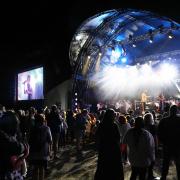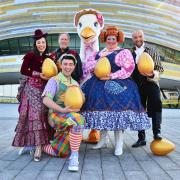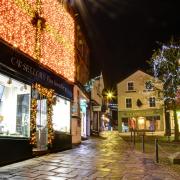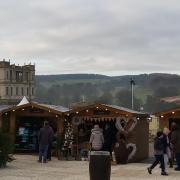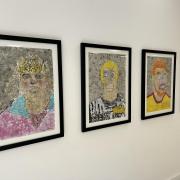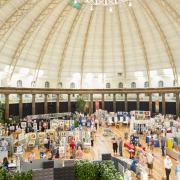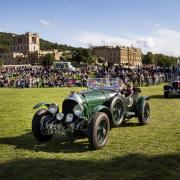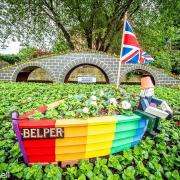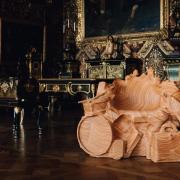Crosses, carvings, churches, crypts and coffins - a look at Derbyshire’s Anglian heritage

By the 7th century AD Derbyshire had become part of the Anglo-Saxon kingdom of Mercia (the Middle Kingdom), though its proximity to Northumbria (North Derbyshire formed the frontier line) meant that Northumbrian influences in art and religion are found within the county. Hrepandun (Repton) was the capital of Mercia under King Penda, whilst Northworthy (Derby) was an important regional trading centre on the River Derwent. Apart from the abundance of place names relating to this period there is a good deal of evidence of Anglian Mercia extant in Derbyshire, much of it in the shape of carved stone monuments of the period.
Bakewell (Baedecca’s Well) the site of a spring, from the Mercian waella, was a centre of Mercian art and sculpture judging from the wealth of stonework surviving in and around the church. In the churchyard is a fine Mercian style cross dating from around AD 800. Such crosses served several functions including preaching locations before the establishment of a permanent church. Later ones may have been memorials to important ecclesiastics. Many may have been painted in bright colours, though the paint has long since faded away.
The Bakewell cross has short stumpy arms and lacks the top part of the head. Three sides have a vine scroll motif whilst the eastern one carries scenes from Christ’s life, including at the broken-off top, a depiction of the crucifixion. The western head shows a horse rider apparently trampling a human figure, and below this is an animal, perhaps a squirrel, an Anglian symbol for a divine messenger. A smaller cross stands nearby, brought from Two Dales many years ago, though its ultimate origin is believed to have been Beeley Moor. It is decorated with both scrolls and plaits.
Bakewell Church is a Norman foundation, remodelled in Medieval times and rebuilt in the 1840s. When the Norman walls were dismantled they were found packed with a variety of worked stone pieces which seem to have been recycled from the churchyard. Included were examples of Anglo-Danish hogsback tombs, of which Thomas Bateman removed the better examples. One in Sheffield Museum is decorated with fantastical beasts and bears a Runic inscription which reads Pray for Helga. Many of the stones, which include parts of crosses, are now in the Church porch or inside the building itself.

The finest cross is in Eyam churchyard, though it probably once stood on Eyam Moor. It was found dismantled in the churchyard and re-erected where it now stands. Unfortunately some miscreant had sawed off the top part of the shaft, destroying the original smooth line between the body and the cross itself. The monument, which is in Northumbrian style, dates from around AD 800; the eastern face is decorated with vine scrolls with angels in the cross-arms blowing trumpets, whilst the western side incorporates human figures including the Virgin and child. The upper figure has been decapitated by the individual who truncated the shaft. Above the figures are further angels in the cross-head, the cross-sides are embellished with plaited work, while the vertical edges are cabled.
The most singular Derbyshire stone is the Wirksworth grave-lid, found upside-down some two feet deep in front of the chancel rail of St Mary’s Church in 1820, which was described as ‘one of the most interesting sculptural remains of its date.’ The lid is gabled in section and both ends have been broken off. It undoubtedly once covered a sarcophagus containing the remains of an important early ecclesiastic, and the lavish decoration suggests it was intended to be seen, perhaps sunk into the floor of the Anglian building. It was probably an instruction artefact in those illiterate times, and the scenes on the slab derive from the life of Christ.
At the top left Christ can be seen washing his disciples’ feet; to the right is the cross, with an early depiction of the saviour as the Lamb of God accompanied by the four symbols of the apostles. At the top right Christ lies in his sepulchre, whilst at the bottom left he descends into Hell to release the damned, excepting the three perpetually doomed sinners, Pilate, Cain and Judas, who seethe eternally in a boiling vat. To the right of this depiction, Christ ascends to Heaven, whilst the bottom right-hand scene represents St Peter preaching from a rather small boat. Stylistically the lid is Mercian, dating from around AD 800; other Anglian fragments can be seen built into the church walls.
There is little pre-Norman architectural evidence visible in the county apart from remnants embodied in later buildings such as churches. Bakewell, Ault Hucknall and Bradbourne have Anglian features absorbed into subsequent structures, but the only religious edifice with actual standing remains, dating from the 8th century AD, is the parish church of St Wystan at Repton. In AD 653 King Penda’s son married the daughter of King Oswy of Northumbria here, and the Bishop of Mercia founded a monastery. The outside walls at the east end of the present church are 8th century and have the string courses and long-and-short stonework down the corners so typical of later Anglo-Saxon building practice. This part of the church was probably added onto the east end of the Mercian fabric as a baptistry, later adapted as a royal mausoleum. Under the present chancel is a superb crypt, forgotten for centuries until its rediscovery in the 1790s.

Sixteen feet square and nine feet high, the crypt, an architectural gem, is vaulted by four spirally-wreathed columns perhaps added in the early 9th century. The subterranean room, sunk some four feet into the ground, became a burial vault for several Mercian monarchs of the 8th/9th century. Among the kings believed to have been buried here were Aethelbald (d.757), Wiglaf (d.840) and his grandson Wigstan, murdered in a power struggle in 849. The bodies were placed in containers in the niches visible on the four sides of the crypt, presumably after defleshment. Wigstan became a saint and the crypt a place of pilgrimage as can be seen by the two flights of narrow curving stairs leading down from the transept, one forming the entrance, the other the exit, used to speed the flow of devotees in busy periods. When the Viking army approached the monastery in 873 the bodies were presumably removed to safety.
A broken stone cross found near the crypt may commemorate Aethelbald. The remnant bears a carving of a mailed horseman brandishing a sword and shield, possibly the murdered king himself, whilst inside the church is a replica of a finely-carved grave-lid found broken during excavations in the 1980s west of the church. The original might well have covered the remains of the Mercian king Merewahl who may have been interred in a sunken-floored chapel in the later 7th century. At the head of each stair leading to the crypt are the bases of two columns which helped support the church roof in Anglian times, whilst two complete columns from the period can be seen in the church porch and come from the east side of the nave.
In Derby Museum is a fine sarcophagus, minus most of the lid, unearthed in the church foundations during the demolition of St Alkmund’s Church in the 1960s. The massive stone coffin was undoubtedly prepared for the saint whose name the church bore. Alkmund was the younger son of Alhred, King of Northumbria who was deposed in 774. Alkmund was reputedly murdered in 800 by Eardwulf who had usurped the throne. He was canonised shortly after death and was buried at Lilleshall until a purpose-built church was erected in Northworthy, where he was reinterred. St Alkmund’s Church ‘in which place he is famed for many miracles’ duly became a focus for pilgrims.
The saint’s remains were doubtless placed in the splendid sarcophagus which was embellished with interlaced knotwork similar to that on the Derbyshire stone crosses. It was obviously intended to be seen, and it may have been placed flanking the altar at the east end of the nave like that of St Cuthbert at Durham, where it would have formed a shrine accessible to the many pilgrims who came to worship there. It was later buried under the foundations of the medieval edifice, along with other pieces of pre-Norman carved stonework, including the shafts of several crosses.
This county of ours, long thought of as a historic backwater, was the centre of important events in Anglian times. Repton was once the capital of Mercia and the resting place not only of a series of Mercian kings, but of two important Anglian saints, Alkmund and Wystan, both of whom were worshipped in two Derbyshire shrines.






